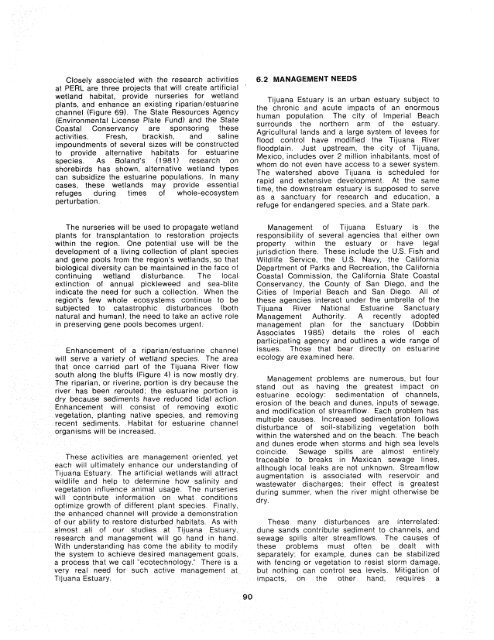The Ecology of Tijuana Estuary, California: An Estuarine Profile
The Ecology of Tijuana Estuary, California: An Estuarine Profile
The Ecology of Tijuana Estuary, California: An Estuarine Profile
Create successful ePaper yourself
Turn your PDF publications into a flip-book with our unique Google optimized e-Paper software.
Closely associated with the research activities<br />
at PERL are three ~rojects that will create artificial '<br />
wetland habitat, provide nurseries for wetland<br />
plants, and enhance an existing riparian/estuarine<br />
channel (Figure 69). <strong>The</strong> State Resources Agency<br />
(Environmental License Plate Fund) and the State<br />
Coastal Conservancy are sponsoring these<br />
activities. Fresh, brackish, and saline<br />
impoundments <strong>of</strong> several sizes wiil be constructed<br />
to provide alternative habitats for estuarine<br />
species. As Boland's (1981) research on<br />
shorebirds has shown, alternative wetland types<br />
can subsidize the estuarine populations. In many<br />
cases, these wetlands may provide essential<br />
refuges during times <strong>of</strong> whole-ecosystem<br />
perturbation.<br />
6.2 MANAGEMENT NEEDS<br />
<strong>Tijuana</strong> <strong>Estuary</strong> is an urban estuary subject to<br />
the chronic and acute impacts <strong>of</strong> an enormous<br />
human population. <strong>The</strong> city <strong>of</strong> Imperial Beach<br />
surrounds the northern arm <strong>of</strong> the estuary.<br />
Agricultural lands and a large system <strong>of</strong> levees for<br />
flood control have modified the <strong>Tijuana</strong> River<br />
floodplain. Just upstream, the city <strong>of</strong> <strong>Tijuana</strong>,<br />
Mexico, includes over 2 million inhabitants, most <strong>of</strong><br />
whom do not even have access to a sewer system.<br />
<strong>The</strong> watershed above <strong>Tijuana</strong> is scheduled for<br />
rapid and extensive development. At the same<br />
time, the downstream estuary is supposed to serve<br />
as a sanctuary for research and education, a<br />
refuge for endangered species, and a State park.<br />
<strong>The</strong> nurseries will be used to propagate wetland<br />
plants for transplantation to restoration projects<br />
wlthin the region. One potential use will be the<br />
development <strong>of</strong> a living collection <strong>of</strong> plant species<br />
and gene pools from the region's wetlands, so that<br />
b~oioglcal diversity can be maintained in the face <strong>of</strong><br />
continuing wetland disturbance <strong>The</strong> local<br />
extinct~on <strong>of</strong> annual pickleweed and sea-blite<br />
indlcate the need for such a collection When the<br />
reglon's few whole ecosystems continue to be<br />
subjected to catastrophic disturbances (both<br />
natural and human), the need to take an active role<br />
in preserving gene pools becomes urgent<br />
Enhancement <strong>of</strong> a riparian/estuarfne channel<br />
will serve a variety <strong>of</strong> wetland spectes <strong>The</strong> area<br />
that once carried part <strong>of</strong> the <strong>Tijuana</strong> River flow<br />
south along the bluffs (Figure 4) is now mostly dry<br />
<strong>The</strong> riparian, or riverine, portion IS dry because the<br />
river has been rerouted, the estuarine portion is<br />
dry because sediments have reduced tidal action<br />
Enhancement will cons~st <strong>of</strong> removing exotic<br />
vegetation, planting native species, and removing<br />
recent sediments Habitat for estuarine channel<br />
organisms wrll be increased.<br />
<strong>The</strong>se activrl~es are management oriented, yet<br />
each will ultimately enhance our understandrng <strong>of</strong><br />
<strong>Tijuana</strong> <strong>Estuary</strong> <strong>The</strong> artificial wetlands wiil attract<br />
wildlrfe and help to determ~ne how sal~n~ty and<br />
vegetation tnfluence animal usage <strong>The</strong> nurseries<br />
will contribute ~nformat~on on what conditions<br />
optimize growth <strong>of</strong> d~fferent plant specres Flnally,<br />
the enhanced channel wrll prov~de a demonstration<br />
<strong>of</strong> our ability to restore disturbed habitats As with<br />
elmost at! <strong>of</strong> our studies at <strong>Tijuana</strong> <strong>Estuary</strong>.<br />
research and management will go hand in hand<br />
With understanding has come the abrlrty to rnod~fy<br />
the system to achieve desired management goals,<br />
a process that we call "ecatechnology." <strong>The</strong>re is a<br />
very real need for such actrve management at<br />
<strong>Tijuana</strong> <strong>Estuary</strong><br />
Management <strong>of</strong> <strong>Tijuana</strong> <strong>Estuary</strong> is the<br />
responsibility <strong>of</strong> several agencies that either own<br />
property within the estuary or have legal<br />
jurisdiction there. <strong>The</strong>se include the U.S. Fish and<br />
Wildlife Service, the U.S. Navy, the <strong>California</strong><br />
Department <strong>of</strong> Parks and Recreation, the <strong>California</strong><br />
Coastal Commission, the <strong>California</strong> State Coastal<br />
Conservancy, the County <strong>of</strong> San Diego, and the<br />
Cities <strong>of</strong> Imperial Beach and San Diego. All <strong>of</strong><br />
these agencies interact under the umbrella <strong>of</strong> the<br />
<strong>Tijuana</strong> River National <strong>Estuarine</strong> Sanctuary<br />
Management Authority. A recently adopted<br />
management plan for the sanctuary (Dobbin<br />
Associates 1985) details the roles <strong>of</strong> each<br />
participating agency and outlines a wide range <strong>of</strong><br />
issues. Those that bear directly on estuarine<br />
ecology are examined here.<br />
Management problems are numerous, but four<br />
stand out as having the greatest impact on<br />
estuarine ecology: sedimentation <strong>of</strong> channels,<br />
erosion <strong>of</strong> the beach and dunes, inputs <strong>of</strong> sewage,<br />
and modification <strong>of</strong> streamflow. Each problem has<br />
multiple causes. Increased sedimentation follows<br />
disturbance <strong>of</strong> soil-stabilizing vegetation both<br />
within the watershed and on the beach. <strong>The</strong> beach<br />
and dunes erode when storms and high sea levels<br />
coincide. Sewage spills are almost entirely<br />
traceable to breaks in Mexican sewage lines.<br />
although local leaks are not unknown. Streamflow<br />
augmentation is associated with reservoir and<br />
wastewater discharges: their effect is greatest<br />
during summer, when the river might otherwise be<br />
dry.<br />
<strong>The</strong>se many drsturbances are interrelated.<br />
dune sands contribute sediment to channels, and<br />
sewage spills alter streamflows <strong>The</strong> causes <strong>of</strong><br />
these problems must <strong>of</strong>ten be dealt wrth<br />
separately, for exampie, dunes can be stabll~zed<br />
with fencrng or vegetation to reslst slarm damage,<br />
but nothing can control sea levels. Mitigation <strong>of</strong><br />
impacts, on the other hand, requires a

















